Solution: Operating $\mathrm{C}_{1} \rightarrow \mathrm{aCl}_{1}$ $=\frac{1}{a}\left|\begin{array}{ccc} a^{2} & b-c & c+b \\ a^{2}+a c & b & c-a \\ a^{2}-a b & b+a & c...
Prove that
Solve the following equations: 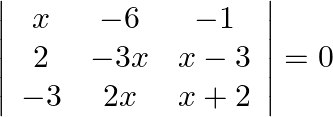
Solution: Expanding with R1 $\begin{array}{l} 0=x\left(-3 x^{2}-6 x-2 x^{2}+6 x\right)+6(2 x+4+3 x-9)-1(4 x-9 x) \\ 0=x\left(-5 x^{2}\right)+6(5 x-5)-1(-5 x) \\ 0=-5 x^{3}+30 x-30+5 x \\ 0=-5...
Solve the following equations: 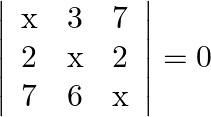
Solution: Operating $R 1 \rightarrow R 1+R_{2}+R_{3}$ $0=\left|\begin{array}{ccc} x+9 & x+9 & x+9 \\ 2 & x & 2 \\ 7 & 6 & x \end{array}\right|$ Taking $(x+9)$ common from...
Solve the following equations: 
Solution: Operating $C_{1} \rightarrow C_{1}+C_{2}+C_{3}$ $0=\left|\begin{array}{ccc} x+9 & 3 & 5 \\ x+9 & x+2 & 5 \\ x+9 & 3 & x+4 \end{array}\right|$ Taking $(x+9)$ common...
Solve the following equations: 
Solution: $\text { Operating } \mathrm{Cl} \rightarrow \mathrm{Cl}+\mathrm{C}_{2}+\mathrm{C}_{3}$ $0=\left|\begin{array}{ccc} 3 x-8+3+3 & 3 & 3 \\ 3+3 x-8+3 & 3 x-8 & 3 \\ 3+3+3 x-8...
Solve the following equations: 
Solution: Operating $\mathrm{Cl} \rightarrow \mathrm{Cl}+\mathrm{C}_{2}+\mathrm{C}_{3}$ $\left|\begin{array}{ccc} x+a+b+c & b & c \\ x+a+b+c & x+b & c \\ x+a+b+c & b & x+c...
Solve the following equations: 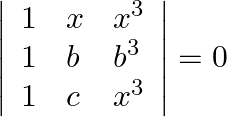
Solution: Operating $R 1 \rightarrow R 1^{-} R_{2}, R_{2 \rightarrow R 2}-R_{3}$ $\left|\begin{array}{ccc} 0 & x-b & x^{3}-b^{3} \\ 0 & b-c & b^{3}-c^{3} \\ 1 & c & c^{3}...
Show that  is a root of the equation
is a root of the equation 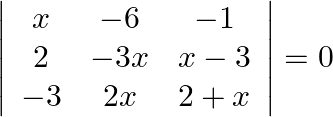 .
.
Solution: Operating $R_{1} \rightarrow R_{1}-R_{2}$ $\begin{aligned} 0 &=\left|\begin{array}{ccc} x-2 & -6+3 x & -1-x+3 \\ 2 & -3 x & x-3 \\ -3 & 2 x & 2+x...
Without expanding the determinant, prove that: 
Solution: $\text { Operating } R 1 \rightarrow R 1^{-} R_{3}, R_{2 \rightarrow R_{2}-R 3}$ $\begin{array}{l} \left|\begin{array}{ccc} 0 & \mathrm{a}-\mathrm{c} &...
Without expanding the determinant, prove that: 
Solution: Operating $R_{1} \rightarrow R_{1}-R_{2}, R_{2} \rightarrow R_{2}-R_{3}$ $\rightarrow\left|\begin{array}{ccc} 0 & \mathrm{a}-\mathrm{b} & \mathrm{b} c-\mathrm{ac} \\ 0 &...
Prove that 
Solution: Operating $R_{1} \rightarrow R_{1}-R_{2}, R_{2} \rightarrow R_{2}-R_{3}$ $\begin{array}{l} =\left|\begin{array}{ccc} 0 & \mathrm{a}^{2}+\mathrm{bc}-\mathrm{b}^{2}-\mathrm{ac} &...
If  and
and 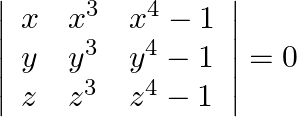 , prove that
, prove that 
Solution: By properties of determinants, we can split the given determinant into 2 parts $\rightarrow 0=\left|\begin{array}{lll} \mathrm{x} & \mathrm{x}^{3} & \mathrm{x}^{4} \\ \mathrm{y}...
Using properties of determinants prove that: 
Solution: Operating $R_{1} \rightarrow R_{1}-R_{2}, R_{2} \rightarrow R_{2}-R_{3}$ $\begin{array}{l} =\left|\begin{array}{ccc} (a+1)(a+2)-(a+2)(a+3) & a+2-a-3 & 0 \\ (a+2)(a+3)-(a+3)(a+4)...
Using properties of determinants prove that:  , where
, where  are in AP.
are in AP.
Solution: Given that $\alpha, \beta, \gamma$ are in an $A P$, which means $2 \beta=\alpha+\gamma$ Operating $R_{3} \rightarrow R_{3}-2 R_{2}+R_{1}$ $\begin{array}{l} =\left|\begin{array}{ccc} x-3...
Using properties of determinants prove that: 
Solution: Taking $a, b, c$ from $C_{1}, C_{2}, C_{3}$ $=a b c\left|\begin{array}{ccc} -b^{2}-c^{2}+a^{2} & 2 b^{2} & 2 c^{2} \\ 2 a^{2} & b^{2}-c^{2}-a^{2} & 2 c^{2} \\ 2 a^{2} &...
Using properties of determinants prove that: 
Solution: $=\left|\begin{array}{lll} b(b-a) & b-c & c(b-a) \\ a(b-a) & a-b & b(b-a) \\ c(b-a) & c-a & a(b-a) \end{array}\right|$ Taking (b-a) common from $\mathrm{C}_{1},...
Using properties of determinants prove that: 
Solution: $=\left|\begin{array}{ccc} b^{2}+c^{2}+2 b c & a b & a c \\ a b & a^{2}+c^{2}+2 a c & b c \\ a c & b c & a^{2}+b^{2}+2 a b \end{array}\right|$ Operating $R_{1}...
Using properties of determinants prove that: 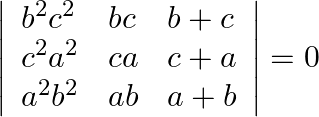
Solution: Expanding with R1 $\begin{array}{l} =b^{2} c^{2}\left(a^{2} c+a b c-a b c-a^{2} b\right)-b c\left(a^{3} c^{2}+a^{2} b c^{2}-a^{2} b^{2} c-a^{3} b^{2}\right)+(b+c)\left(a^{3} b c^{2}-a^{3}...
Using properties of determinants prove that: 
Solution: Operating $\mathrm{C}_{1} \rightarrow \mathrm{aCl}_{1}$ $\frac{1}{a}\left|\begin{array}{ccc} a^{2} & b-c & c+b \\ a^{2}+a c & b & c-a \\ a^{2}-a b & a+b & c...
Using properties of determinants prove that: 
Solution: Operating $R_{1} \rightarrow R_{1}+b R_{3}, R_{2} \rightarrow R_{2^{-}} a R_{3}$ $\begin{array}{l} \left|\begin{array}{ccc} 1+a^{2}-b^{2}+2 b^{2} & 2 a b-2 a b & -2 b+b-a^{2}...
Using properties of determinants prove that: 
Solution: $\begin{array}{l} \left|\begin{array}{ccc} b^{2}+c^{2} & a^{2} & a^{2} \\ b^{2} & c^{2}+a^{2} & b^{2} \\ c^{2} & c^{2} & a^{2}+b^{2} \end{array}\right| \\...
Using properties of determinants prove that: 
Solution: $\begin{array}{l} \left|\begin{array}{lll} (b+c)^{2} & a^{2} & b c \\ (c+a)^{2} & b^{2} & c a \\ (a+b)^{2} & c^{2} & a b \end{array}\right| \\...
Using properties of determinants prove that: 
Solution: $\left|\begin{array}{ccc}(\mathrm{m}+\mathrm{n})^{2} & \mathrm{l}^{2} & \mathrm{mn} \\ (\mathrm{n}+\mathrm{l})^{2} & \mathrm{~m}^{2} & \mathrm{ln} \\ (1+\mathrm{m})^{2}...
Using properties of determinants prove that: 
Solution: $\begin{array}{l} \left|\begin{array}{ccc} (\mathrm{x}-2)^{2} & (\mathrm{x}-1)^{2} & \mathrm{x}^{2} \\ (\mathrm{x}-1)^{2} & \mathrm{x}^{2} & (\mathrm{x}+1)^{2} \\...
Using properties of determinants prove that: 
Solution: $\left|\begin{array}{ccc}a^{2} & b^{2} & c^{2} \\ (a+1)^{2} & (b+1)^{2} & (c+1)^{2} \\ (a-1)^{2} & (b-1)^{2} & (c-1)^{2}\end{array}\right|$...
Using properties of determinants prove that: 
Solution: $\left|\begin{array}{ccc} a & b & a x+b y \\ b & c & b x+c y \\ a x+b y & b x+c y & 0 \end{array}\right|$ $\begin{array}{l} \left.=\left(\frac{1}{x...
Using properties of determinants prove that: 
Solution: $\begin{array}{l} \left|\begin{array}{ccc} a+b+c & -c & -b \\ -c & a+b+c & -a \\ -b & -a & a+b+c \end{array}\right| \\ =\left|\begin{array}{ccc} a+b & a+b &...
Using properties of determinants prove that: 
Solution: $\left|\begin{array}{ccc}a & a+2 b & a+2 b+3 c \\ 3 a & 4 a+6 b & 5 a+7 b+9 c \\ 6 a & 9 a+12 b & 11 a+15 b+18 c\end{array}\right|$...
Using properties of determinants prove that: 
Solution: $\begin{array}{l} \left|\begin{array}{ccc} \mathrm{b}+\mathrm{c} & \mathrm{a} & \mathrm{a} \\ \mathrm{b} & \mathrm{c}+\mathrm{a} & \mathrm{b} \\ \mathrm{c} & \mathrm{c}...
Using properties of determinants prove that: 
Solution: $\begin{array}{l} \left|\begin{array}{lll} \mathrm{b}+\mathrm{c} & \mathrm{a}-\mathrm{b} & \mathrm{a} \\ \mathrm{c}+\mathrm{a} & \mathrm{b}-\mathrm{c} & \mathrm{b} \\...
Using properties of determinants prove that: 
Solution: $\begin{array}{l} \left|\begin{array}{ccc} \mathrm{x} & \mathrm{y} & \mathrm{z} \\ \mathrm{x}^{2} & \mathrm{y}^{2} & \mathrm{z}^{2} \\ \mathrm{x}^{3} & \mathrm{y}^{3}...
Using properties of determinants prove that: 
Solution: $\begin{array}{l} \left|\begin{array}{ccc} 3 x & -x+y & -x+z \\ x-y & 3 y & z-y \\ x-z & y-z & 3 z \end{array}\right| \\ =\left|\begin{array}{ccc} x+y+z & -x+y...
Using properties of determinants prove that: 
Solution: $\begin{array}{l} \left|\begin{array}{ccc} \mathrm{x} & \mathrm{x}+\mathrm{y} & \mathrm{x}+2 \mathrm{y} \\ \mathrm{x}+2 \mathrm{y} & \mathrm{x} & \mathrm{x}+\mathrm{y} \\...
Using properties of determinants prove that: 
Solution: $\begin{array}{l} \left|\begin{array}{ccc} a^{2}+2 a & 2 a+1 & 1 \\ 2 a+1 & a+2 & 1 \\ 3 & 3 & 1 \end{array}\right| \\ =\left|\begin{array}{ccc} a^{2}-1 & a-1...
Using properties of determinants prove that: 
Solution: $\begin{array}{l} \left|\begin{array}{ccc} \mathrm{x}+\lambda & 2 \mathrm{x} & 2 \mathrm{x} \\ 2 \mathrm{x} & \mathrm{x}+\lambda & 2 \mathrm{x} \\ 2 \mathrm{x} & 2...
Using properties of determinants prove that: 
Solution: $\left|\begin{array}{ccc}x+4 & 2 x & 2 x \\ 2 x & x+4 & 2 x \\ 2 x & 2 x & x+4\end{array}\right|$ $=\left|\begin{array}{ccc}5 \mathrm{x}+4 & 5 \mathrm{x}+4...
Using properties of determinants prove that: 
Solution: $\begin{array}{l} \left|\begin{array}{lll} \mathrm{x} & \mathrm{a} & \mathrm{a} \\ \mathrm{a} & \mathrm{x} & \mathrm{a} \\ \mathrm{a} & \mathrm{a} & \mathrm{x}...
Using properties of determinants prove that: 
Solution: $\begin{array}{l} \left|\begin{array}{ccc} \mathrm{a}+\mathrm{x} & \mathrm{y} & \mathrm{z} \\ \mathrm{x} & \mathrm{a}+\mathrm{y} & \mathrm{z} \\ \mathrm{x} & \mathrm{y}...
Using properties of determinants prove that: 
Solution: $\begin{array}{l} \left|\begin{array}{ccc} 1 & 1+p & 1+p+q \\ 2 & 3+2 p & 1+3 p+2 q \\ 3 & 6+3 p & 1+6 p+3 q \end{array}\right|\\ =\left|\begin{array}{ccc} -1 &...
Using properties of determinants prove that: 
Solution: $\begin{array}{l} \left|\begin{array}{llll} 1 & \mathrm{~b}+\mathrm{c} & \mathrm{b}^{2}+\mathrm{c}^{2} \\ 1 & \mathrm{c}+\mathrm{a} & \mathrm{c}^{2}+\mathrm{a}^{2} \\ 1...
Using properties of determinants prove that: 
Solution: $\begin{array}{l} \left|\begin{array}{ccc} 1 & 1 & 1 \\ a & b & c \\ b c & c a & a b \end{array}\right| \\ =\left|\begin{array}{ccc} 0 & 0 & 1 \\ a-b &...
Evaluate : 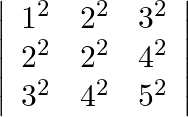
Solution: $\left|\begin{array}{lll} 1^{2} & 2^{2} & 3^{2} \\ 2^{2} & 3^{2} & 4^{2} \\ 3^{2} & 4^{2} & 5^{2} \end{array}\right|=\left|\begin{array}{ccc} 1 & 4 & 9 \\ 4...
Evaluate : 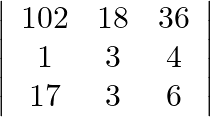
Solution: $\left|\begin{array}{ccc} 102 & 18 & 36 \\ 1 & 3 & 4 \\ 17 & 3 & 6 \end{array}\right|=6 \times\left|\begin{array}{ccc} 17 & 18 & 6 \\ 1 & 6 & 4 \\...
Evaluate: 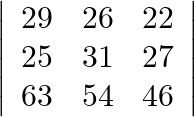
Solution: $\left|\begin{array}{lll}29 & 26 & 22 \\ 25 & 31 & 27 \\ 63 & 54 & 46\end{array}\right|$ $=\left|\begin{array}{ccc}4 & -5 & -5 \\ 25 & 31 & 27 \\ 63...
Evaluate : 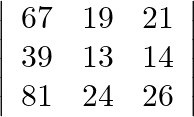
Solution: $\begin{array}{l} \left|\begin{array}{lll} 67 & 19 & 21 \\ 39 & 13 & 14 \\ 81 & 24 & 26 \end{array}\right| \\...
Evaluate 
Solution: $\left|\begin{array}{cc}\sqrt{3} & \sqrt{5} \\ -\sqrt{5} & 3 \sqrt{3}\end{array}\right| \cdot=3 \sqrt{3} \times \sqrt{3}-(-\sqrt{5} \times \sqrt{5})$ $=14$
Evaluate 
Solution: $\begin{array}{l} \left|\begin{array}{cc} 14 & 9 \\ -8 & -7 \end{array}\right|=14 \times(-7)-9 \times(-8) \\ =-26 \end{array}$
For what value of  , the given matrix
, the given matrix ![Rendered by QuickLaTeX.com A=\left[\begin{array}{cc}3-2 x & x+1 \\ 2 & 4\end{array}\right]](https://www.learnatnoon.com/s/wp-content/ql-cache/quicklatex.com-6d1f81dc4f5441083b9e76c825f8968a_l3.png) is a singular matrix?
is a singular matrix?
Solution: For $A$ to be singular matrix its determinant should be equal to 0 . $\begin{array}{l} 0=(3-2 x) \times 4-(x+1) \times 2 \\ 0=12-8 x-2 x-2 \\ 0=10-10 x \\ x=1 \end{array}$
Without expanding the determinant, prove that 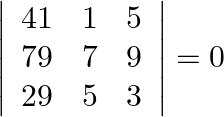 . SINGULAR MATRIX A square matrix
. SINGULAR MATRIX A square matrix  is said to be singular if
is said to be singular if  . Also,
. Also,  is called non singular if
is called non singular if  .
.
Solution: We know that $C_{1} \Rightarrow C_{1}-C_{2}$, would not change anything for the determinant. Applying the same in above determinant, we get $\left[\begin{array}{lll}40 & 1 & 5 \\...
Evaluate 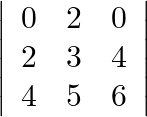
Solution: We know that expansion of determinant with respect to first row is $a_{11} A_{11}+a_{12} A_{12}+a_{13} A_{13}$. $0(3 \times 6-5 \times 4)-2(2 \times 6-4 \times 4)+0(2 \times 5-4 \times 3)$...
Evaluate 
Solution: $\begin{array}{l} \cos 15^{\circ} \cos 75^{\circ}-\sin 75^{\circ} \sin 15^{\circ} \\ =\cos \left(15^{\circ}+75^{\circ}\right) \because \cos A \cos B-\sin A \sin B=\cos (A+B) \\ =\cos...
Evaluate 
Solution: By directly opening this determinant $\begin{array}{l} \cos 65^{\circ} \times \cos 25^{\circ}-\sin 25^{\circ} \times \sin 65^{\circ} \\ =\cos \left(65^{\circ}+25^{\circ}\right) \because...
Evaluate 
Solution: After finding determinant we will get, $\begin{array}{l} \operatorname{Sin} 60^{\circ}=\frac{\sqrt{3}}{2}=\cos 30^{\circ} \\ \operatorname{Cos} 60^{\circ}=\frac{1}{2}=\sin 30^{\circ} \\...
Evaluate 
Solution: After finding determinant we will get a trigonometric identity. $\begin{array}{l} \cos ^{2} \alpha+\sin ^{2} \alpha \\ =1 \end{array}$ $\because \sin ^{2} \theta+\cos ^{2} \theta=1$
Evaluate 
Solution: After finding determinant we will get a trigonometric identity. $\begin{array}{l} 2 \cos ^{2} \theta+2 \sin ^{2} \theta \\ =2 \\ \because \sin ^{2} \theta+\cos ^{2} \theta=1...
Evaluate  .
.
Solution: Find determinant $\begin{array}{l} \sqrt{6} \times \sqrt{24-\sqrt{2}} 20 \times \sqrt{5} \\ \sqrt{1} 144-\sqrt{1} 100 \\ =12-10 \\ =2 \end{array}$
Evaluate  .
.
Solution: It is determinant multiplied by a scalar number 2 , just find determinant of matrix and multiply it by 2 . $\begin{array}{l} 2 \times(35-20) \\ 2 \times 15=30 \end{array}$
If ![Rendered by QuickLaTeX.com \mathrm{A}=\left[\begin{array}{ll}3 & 4 \\ 1 & 2\end{array}\right]](https://www.learnatnoon.com/s/wp-content/ql-cache/quicklatex.com-9332ef694cc023ffd6fab878ba6dae64_l3.png) , find the value of
, find the value of  .
.
Solution: Find the determinant of $A$ and then multiply it by 3 $\begin{array}{l} |A|=2 \\ 3|A|=3 \times 2 \\ =6 \end{array}$
If  , write the value of
, write the value of  .
.
Solution: Simply by equating both sides we can get the value of $x$. $\begin{array}{l} 2 x^{2}+2 x-2\left(x^{2}+4 x+3\right)=-12 \\ \Rightarrow-6 x-6=-12 \\ \Rightarrow-6 x=-6 \\ \Rightarrow x=1...
If  , write the value of
, write the value of  .
.
Solution: This question is having the same logic as above. $\begin{array}{l} 2 x^{2}-40=18+14 \\ \Rightarrow 2 x^{2}=72 \\ \Rightarrow x^{2}=36 \\ \Rightarrow x=\pm 6 \end{array}$
If  , write the value of
, write the value of  .
.
Solution: Here the determinant is compared so we need to take determinant both sides then find $\mathrm{x}$. $\begin{array}{l} 12 x+14=32-42 \\ \Rightarrow 12 x=-10-14 \\ \Rightarrow 12 x=-24 \\...
Evaluate 
Solution: This we can very simply go through directly. $\begin{array}{l} ((a+i b)(a-i b))-((-c+i d)(c+i d)) \\ \Rightarrow\left(a^{2}+b^{2}\right)-\left(-c^{2}-d^{2}\right) \\ \Rightarrow...
Evaluate 
Solution: Theorem: This evaluation can be done in two different ways either by taking out the common things anc then calculating the determinants or simply take determinant. I will prefer first...
If  is the cofactor of the element
is the cofactor of the element  of
of 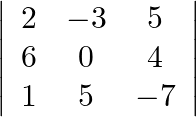 then write the value of
then write the value of  .
.
Solution: Theorem: $A_{i j}$ is found by deleting $j^{t h}$ rowand $j^{t h}$ column, the determinant of left matrix is called cofactor with multiplied by $(-1)^{(i+j)}$ Given: $\mathrm{j}=3$ and...
Let  be a square matrix of order 3, write the value of
be a square matrix of order 3, write the value of  , where
, where  .
.
Solution: Theorem: If $A$ be $k \times k$ matrix then $|p A|=p^{k}|A|$. Given: $p=2, k=3$ and $|A|=4$ $\begin{array}{l} |2 A|=2^{3} \times|A| \\ =8 \times 4 \\ =32 \end{array}$
If  is a
is a  matrix such that
matrix such that  and
and  then write the value of
then write the value of  .
.
Solution: Theorem: If Let $A$ be $k \times k$ matrix then $|p A|=p^{k}|A|$. Given: $\mathrm{k}=3$ and $\mathrm{p}=3$. $\begin{array}{l} |3 \mathrm{~A}|=3^{3} \times|\mathrm{A}| \\ =27|\mathrm{~A}|...
If  is a
is a  matrix such that
matrix such that  and
and  , write the value of
, write the value of  .
.
Solution: Theorem: If $A$ be $k \times k$ matrix then $|p A|=p^{k}|A|$. Given, $\mathrm{p}=4, \mathrm{k}=2$ and $|\mathrm{A}|=5$. $\begin{array}{l} |4 \mathrm{~A}|=4^{2} \times 5 \\ =16 \times 5 \\...

